This is an Exakta VX1000, a 35mm single lens reflex camera made by Ihagee Kamera-Werk AG in Dresden, East Germany between the years 1967 to 1970. The Exakta VX1000 was an evolution of the original Kine Exakta dating back to 1936 featuring the same bayonet lens mount, left handed control layout, and similar trapezoid shaped body, but featured a variety of improvements including an entirely new body, instant return mirror, much shorter throw for the film advance lever, simpler exposure counter, and a modern arrangement of shutter speeds. By the time of the VX1000’s introduction, the Exakta system was showing its age, so these advances helped it to stay relevant for a few extra years.
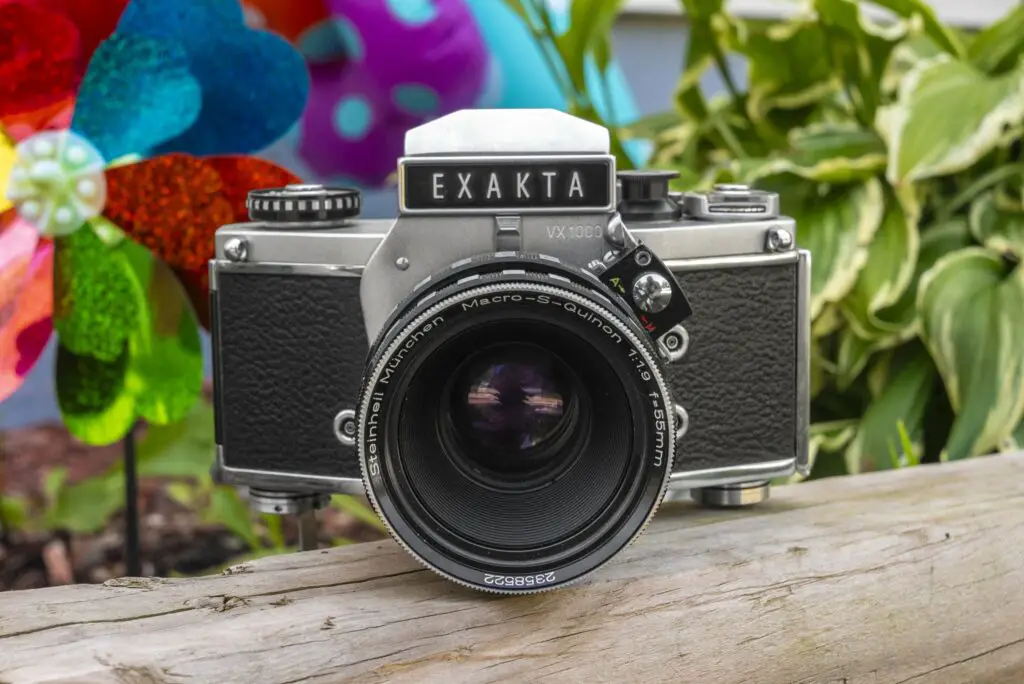 Film Type: 135 (35mm)
Film Type: 135 (35mm)
Lens: 55mm f/1.9 Steinheil München Macro-S-Quinon coated 6-elements in 4-groups
Lens Mount: Exakta Bayonet
Focus: 8.5 inches / 0.22 meters to Infinity w/ Secondary 1.4:1 Macro Extension down to 1.5 inches / 0.04 meters
Viewfinder: Interchangeable SLR Pentaprism
Shutter: Cloth Focal Plane
Speeds: T. B, 12 – 1/1000 seconds
Exposure Meter: None, Optional Metered Viewfinder was Available
Battery: None
Flash Mount: F, FP, and X Flash Sync, 1/60 X-Sync
Other Features: Self-Timer, Cassette to Cassette Transport, Film Cutting Blade, Shutter Speeds down to 12 seconds
Weight: 946 grams, 734 grams (no lens), 610 grams (body only)
Manual (in English): http://www.ihagee.org/Manuals/ECM39-VX1000E68.pdf
Manual (in German): https://www.cameramanuals.org/exakta/exakta_vx_1000_german.pdf
How these ratings work |
The Ihagee Exakta VX1000 features a number of improvements to the original 1930s Exakta making it a much more user friendly model. An instant return mirror, shorter throw for the film advance, improvements to the film door, and modern flash synchronization make it a capable tool even today. Of course, it still has most of the quirks of earlier models like the left handed controls, film slicing knife, and support for the Exakta bayonet. With an enormous selection of good to great lenses out there, if there was one Exakta you should try, this is it. | ||||||
| Images | Handling | Features | Viewfinder | Feel & Beauty | History | Age | |
| 2 | 1 | 1 | 1 | 2 | 1 | 20% | |
| Bonus | none | ||||||
| Final Score | 9.6 | ||||||
History
For those born in 1970 or later, when asked what the most successful professional 35mm SLR camera of the 20th century was, you’d likely pick a Nikon or Canon model and you’d have a good reason to think that. While the Nikon F certainly makes for a compelling champion of pro-level SLRs, the camera that was produced in larger numbers and for a longer time is the Ihagee Exakta. First released in 1936, the last of the original Exaktas ended production in 1972 and if the numbers on wrotniak’s Taxonomy page are correct over 825,000 were made (I am not counting the consumer level Exa or the Pentacon era Exaktas).
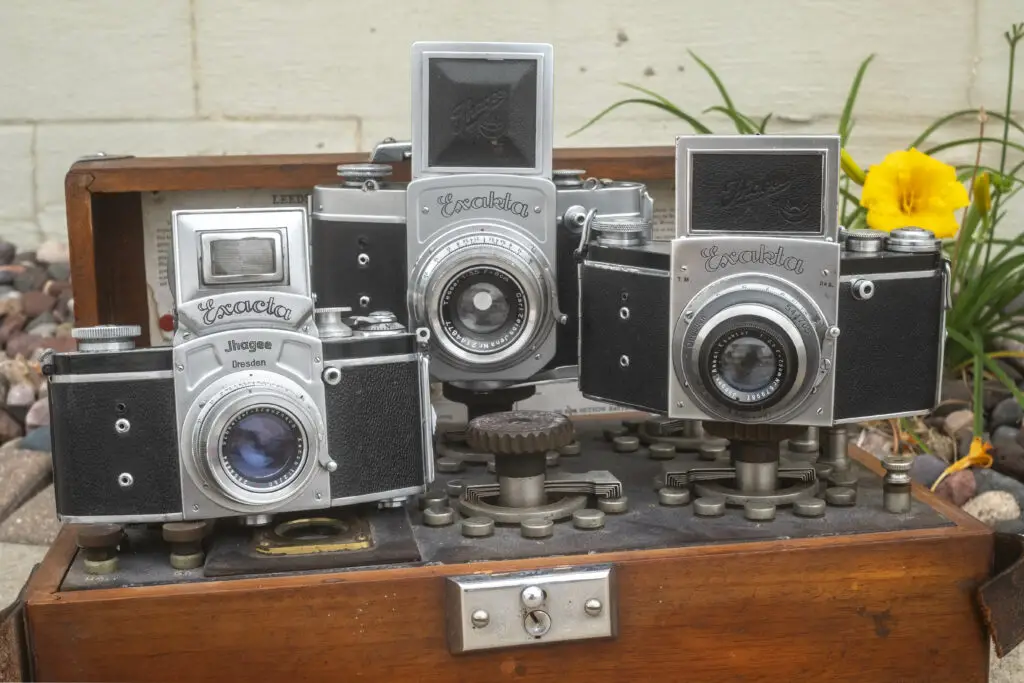
The Exakta wasn’t just the most popular 35mm system SLR, for more than two decades after its release, it was the only 35mm system SLR. Ihagee Exaktas were the camera of choice for scientific, medical, and commercial photographic industries. Millions of lenses using the Exakta bayonet mount were made by companies all over the world like Canon and many others. Whole camera systems by Tokyo Kogaku (Topcon) and Mamiya shared the same lens mount as well.
Although the original Kine Exakta was incrementally updated from the original 1936 waist level viewfinder only design, most changes were minor and to the untrained eye, most models could easily be mistaken for each other.
In 1960, competition from other German and Japanese camera makers meant that the Exakta was no longer the only option and the workers at Ihagee Kamera-Werk AG in Dresden realized they needed to update the camera or risk it falling out of favor with consumers. The first change came in 1960 with a cosmetic refresh. The familiar sculpted Exakta logo in front of the viewfinder was replaced with a chrome on black rectangular logo with Exakta written in plain letters. In 1963 more changes were made to the film reminder dial, the rewind crank gained a fold out handle, the finder release latch was removed, and the shutter speeds were updated to follow the modern pattern (so no more 1/100 and 1/50 shutter speeds).
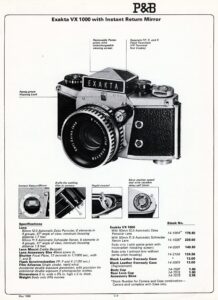
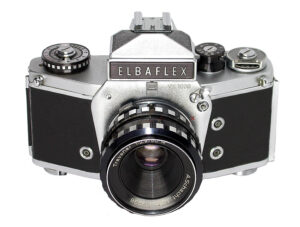
In 1967 the Exakta was renamed the VX1000 in most markets and Elbaflex VX1000 in some European countries. With this new model, the Exakta saw its biggest changes since 1950, with an entirely new body, plus the addition of an instant return mirror. No longer would the Exakta’s viewfinder be blacked out until after advancing the film. The finder release latch returned (apparently its removal from the previous model was poorly received), the film advance lever was redesigned, the separate exposure counter reset knob was removed, and the slow speed knob was decreased in size.
As was the case with previous models, the VX1000 was exported all over the world, including the United States. One of the largest Exakta importers was Ponder & Best who sold the VX1000 body only or with a 50mm f/2 Zeiss Pancolar lens for $149.50 and $179.50 respectively. When adjusted for inflation, these prices compare to about $1300 and $1580 respectively.
The cosmetic and functional changes made to the Exakta throughout the 1960s clearly had a positive effect as the sales for the Exakta VX IIb and VX1000 exceeded 218,000 units for just those two versions, representing more than a quarter of all Exaktas sold throughout its entire run.
Reviews for the camera were strong with many articles praising the build quality, flexibility of the system, and performance of its lenses. Although the Japanese camera industry was well on its way to becoming the dominant source for photographic goods, Germany still had a lot of good will for photographers. German cameras and lenses were still highly respected, and the Exakta was the most well known of all German SLRs, so demand was still quite high.
The following 10 page article comes from an English translation of a French photo magazine called “Phot Argus” and covers the VX1000, its lenses, and the new Travmat metered prism which was also available at the same time.
I could not find any contemporary reviews of the VX1000 in any American magazines, likely because by the time, even a new Exakta was still old news, but I did find a short summary of later Exaktas, including the VX1000 in Jason Schneider’s January 1980 edition of his Camera Collector column where he called it the last of the true Exaktas and commended its instant return mirror and excellent build quality.
The Exakta VX1000 and its name variants were produced until 1970, making them one of the last of the original Exaktas to be produced. The only original model in production longer was the simpler VX500. After that, the Exakta name would be reused a couple of other times, most notably by the East German conglomerate VEB Pentacon in a similar, but unrelated camera called the Exakta RTL1000.
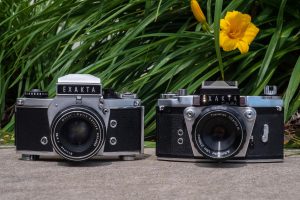
By this time, Johan Steenbergen, the man responsible for the creation of Ihagee in the 1930s was no longer involved in the company, but sought to create a new Ihagee, which would eventually be called Ihagee West. In 1966, he would release a completely unrelated and all new Exakta with many improvements, including a larger and more substantial bayonet lens mount and the inclusion of right handed controls. This new camera, called the Exakta Real turned out to be extremely expensive, had a reputation for poor reliability, and was quickly discontinued.
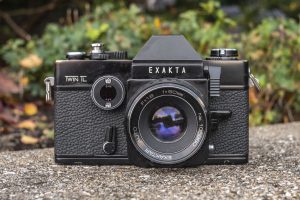
In 1970, Ihagee West realized that the Exakta Real was a bit too ambitious of a camera for them took one last chance at re-launching his brand by outsourcing production of his second camera to Japanese camera maker, Cosina. The new Ihagee West Exakta Twin TL shared the same lens mount as the Exakta Real, but it otherwise a pretty ordinary Japanese SLR. This camera also did not sell well, and an attempt to release a version that used the M42 screw mount failed to generate much excitement, bringing to the end production of Exakta SLRs.
By the mid 1970s, Ihagee West had ceased camera making operations and what was left of Steenbergen’s original Ihagee had been fully folded into VEB Pentacon, never to use the name again.
Today, the impact of the Exakta’s legacy is a bit muddy. One one hand, as one of the longest lived camera makers and pioneers of 35mm SLRs, their place in camera history is undeniable. If you were a professional photographer in the 1940s or 50s, the Exakta system was the one you wanted. Even if you weren’t, I suspect a large number of non professionals drooled over the latest models in camera store display windows. Even if you never owned an Exakta SLR, there is a chance you owned an SLR made by Tokyo Kogaku (Topcon) or Mamiya who also used the mount.
However, despite its rich history and long run, by the 1970s, the name Exakta exited the minds of the photographic world, especially out west. Japanese brands like Nikon, Canon, and Minolta, and established German marques like Leica and Rollei still attracted the buying dollars of photographers around the world. With no link to the present, the Exakta brand is largely forgotten, remembered only by those around when they reigned supreme. Still, if you’re getting back into film cameras, and are tired of the same basic 35mm formula used over and over, give an Exakta a shot. The VX1000 is one of the more modern models, is easy to find used, and generally sells for very little. You could certainly do a lot worse!
My Thoughts
When I first started collecting cameras, I was drawn to the Exakta because it looked like no other camera I had seen until that point. I had long been using film and digital SLRs from the 90s and early 2000s that all had relatively the same shape, ergonomics, and features. The Exakta was nothing like I ever had seen before, and even though it was slow in operation., I loved using it and the images I got from it.
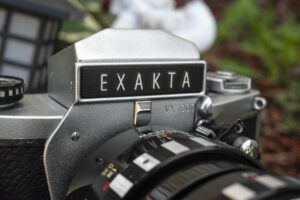
In the years since that first Exakta, I’ve come across many others and they all appeal to me in the same way. I was aware that the later models looked a little different, but I never bothered to check one out because I assumed the changes were just cosmetic. When I first handled this VX1000, I was pleasantly surprised by its improvements to the film advance and film compartment, and also its instant return mirror. This was a modern (ish) Exakta, and one that was different enough from those early models to be worthy of a second review.
At a glance the VX1000 looks like a refreshed Kine Exakta or Exakta Varex. After all, they share the same left handed film advance and shutter release, the lens mount, and a similar design to the removable viewfinder. But once you get one in your hand and can do a direct comparison, the new model is more than a simple refresh. The body is entirely new. The VX1000 is a tad wider and has completely different trim. On the scale, without lens and viewfinder removed, the VX1000 weighs 612 grams, about 20 more than a Varex model. Depending on which viewfinder and lens you add, the gap can widen or narrow. One things for sure though, Ihagee Kamera-Werk AG did not cheap out on build quality. The VX1000 is an all metal camera, built to a high quality standard, that should make it just as reliable as the models that came before it.
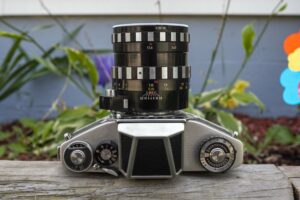
Looking down upon the top plate, the VX1000 has many of the same controls in the same positions, but everything looks new and a bit more modern. Gone is the small wheel for resetting the exposure counter. The new model still requires you to reset it when loading in a new roll of film, but the manner in which it is done changes to you directly rotating the counter directly through the opening near the front of the camera.
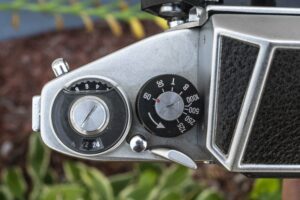
The film advance lever is still wound by your left hand but has a shorter throw than before, allowing you to fully advance the film to the next exposure in a single motion. The shape of the handle is a bit more ergonomically pleasing as well. The shutter speed selector is pretty similar, although it is painted black with silver numbers on it instead of all chrome like the previous models. The arrangement is speeds is modern too, so gone are speeds like 1/150, 1/100, and 1/50, instead are 1/125, 1/60, and 1/30. The speed selector still supports T and B modes, either of which are still needed to use the slow speed governor.

The center of the top plate is dominated by the interchangeable viewfinder. I’ve read online that viewfinders for the VX series are not completely interchangeable with Varex Exaktas, but of the few models I have, I was able to swap both waist level and pentaprism viewfinders between my Varex and VX1000 models without issue. Perhaps some of the metered prisms don’t work, but I was unable to test that. In either case, the VX1000 still works the same way with a release lever on the front face of the camera which allows you to pull the viewfinder straight up. Also like the earlier models, the focusing screen is part of the viewfinder, so when you take it out, the focusing screen is no longer there, and you wont be able to use the viewfinder without it.
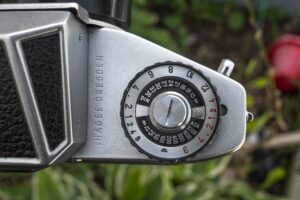
To the right of the viewfinder is the combined self timer and slow speed governor, which functions the same way as on earlier Exaktas. The VX1000 model also adds an inner film speed reminder dial in the center. The arrangement of the speeds is a little different and spaced out more than the original model too, which in my opinion makes it even more confusing to use. Also, like the original model, there is a gap in speeds between 1/8 and 1/30. There is no 1/15 setting anywhere on the camera just like the original camera is missing a 1/10 speed. In previous Exakta reviews, I explain how the self-timer and slow speed governor works, so I don’t want to repeat myself once again. If you need to know how it works, check out the manual linked above, or just read one of my previous Exakta reviews.
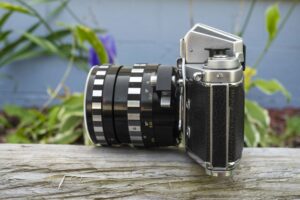
The Exakta’s trapezoid body has always had good symmetry. One improvement made is the new film door lock, which is just a sliding tab on the camera’s left side. Although this looks like the lock on most 35mm cameras, it is a bit of a shame Ihagee couldn’t have gone “full modern” and come up with a method that involves pulling up on the rewind knob to release the lock.
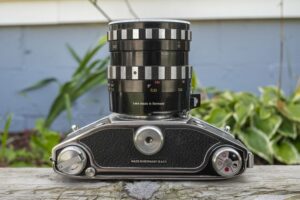
The bottom of the camera shares some similarities with the older models. Two feet are on each end of the camera with a raised 1/4″ tripod socket directly beneath the lens mount in the center of the camera’s weight. The rewind knob on the left has a fold out handle and a film reminder dial on the right knob.

The film slitter blade is still here next to the rewind knob as on all previous 35mm Exaktas. For someone who has never seen an Exakta before, this is a unique feature which allows you to slice a strip of film, mid roll, so that you can wind it in a cassette and remove it from the camera, without having to rewind it first. A sticker that says “Made in Germany (East)” clarifies where the camera was made, although why they couldn’t have just said “East Germany” is anyone’s guess.
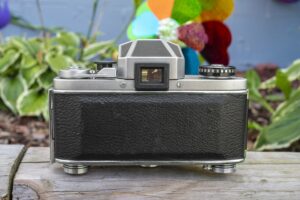
Around back, the VX1000 is basically unchanged from the original model, with only minor cosmetic tweaks. The chrome rectangular frame found on earlier Exaktas is missing, replaced instead by a large piece of body covering. The rectangular eyepiece of the prism is still there, and that’s it!
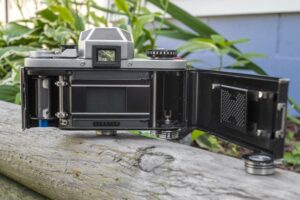
Improvements to a film door might seem minor if you’ve never handled both an early Exakta and a later model like the VX1000, but the door opening for the film compartment is much better on the later cameras. The earlier camera’s method of removing a lock on the bottom foot of the camera and prying the door open always felt clunky to me and depending on the condition of the camera, even a minor ding to the rear door, could render the camera extremely hard to open. With the VX1000, the film compartment opens like most other SLRs.
All 35mm Exaktas transport film from right to left onto a removable metal take up spool. The reason for the removable spool is to allow for cassette to cassette transport, which is why that film cutting knife is still here. On this Exakta, the take up spool has an anodized blue metal piece in the center, although most removable spools from other cameras, plus the inner core of a regular 35mm cassette can be used too. The film pressure plate has a raised border and several bumps which help reduce friction as film passes over it with the door shut. The door hinge and the channels above and below the film gate have fabric light seals, which on this camera are holding up well and should not need to be replaced.
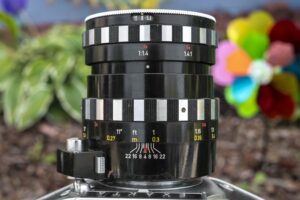
Millions of lenses were made in the Exakta mount, so what you see on the top of the lens is going to vary wildly with looks and the location of its controls. The Steinheil München Macro-S-Quinon on this camera is a bit unusual compared to the Carl Zeiss Jenas and Meyer Optik lenses often found on Exaktas in that the aperture ring is located at the extreme front edge of the lens with prominent click stops from f/1.9 to f/22. The focus ring is made of metal and closest to the body. This lens requires an almost complete 360 degree rotation from its minimum 8.5 inch to infinity setting.
If you’re wondering why I said 8.5 inches here, yet in the specifications at the beginning of this article, I say 1.5 inches, that’s because the Steinheil München Macro-S-Quinon is a double extension lens with a second “macro only” helix right behind the aperture ring. With the lens focused down to 8.5 inches, the macro ring is unlocked and lets you extend the front of the lens getting much closer than 8.5 inches. Instead of distance markings however, reproduction ratios representing a 1:1.4 ratio down to 1.4:1. At its minimum focus distance, the front of the lens physically touches most objects you’d be photographing. This would require either backlit subjects or some sort of advanced ring lighting system to make good use of.
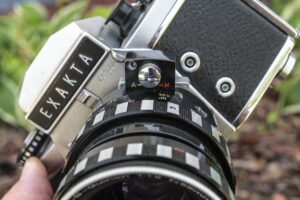
Since the Exakta mount does not have any internal coupling for automatic lenses, many Exakta lenses use an external coupling in the form of a secondary shutter release that sits in front of the main one. The Steinheil München Macro-S-Quinon has a large button as seen in the image to the right which when pressed, pushes in on the main body shutter release. This external coupling has both an Automatic and Manual mode, indicated by a green “A” and red “M”. With a button on the side pushed in the direction of the green “A”, the lens remains wide open at any selected f/stop and automatically stops down immediately before firing the shutter. With it in the direction of the red “M”, changes to the aperture ring immediately stop down the lens.
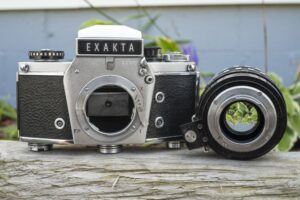
Up front, the Exakta bayonet mount has been unchanged since the original version in 1936. A hinged lever to the right of the mount is used to lock a lens in place. To remove it, press in on the lever and rotate the lens counterclockwise to remove. Mounting the lens is opposite of removing it. One oddity of the Exakta bayonet mount, is that unlike most other bayonet mounts, it is possible to mount the lens incorrectly. The arrangements of the bayonet allow the lens to be 180 degrees from where it should be. This has the side effect of the lens not engaging with the locking pin, but otherwise works fine.
The Exakta VX1000 has three flash sync ports on the front, one on the left is for FP bulbs, and the two on the right are for F and X bulbs. Engravings into the front of the camera remind you of which is which.
With the inclusion of an instant return mirror, Ihagee added a convenient red flag in the upper right corner of the viewfinder as a warning that the shutter is not ready. With earlier Exaktas, it was obvious as the entire viewfinder was blacked out. You could only see through the viewfinder with the shutter ready. On the VX1000, if you see a red flag in the upper right corner, you must first wind the film lever to cock the shutter.
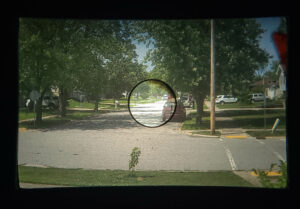
Exakta viewfinders are not like those on most other interchangeable viewfinder SLRs. In the Exakta, the focusing screen is part of the viewfinder, so when you remove it, the focusing screen comes out too. This means that to use an Exakta at waist level, simply removing the prism will not work, you have to actually have an Exakta finder with the ground glass in place. Most Exakta viewfinders have interchangeable focusing screens too. Separating the focusing screen from the viewfinder is just a matter of bending back metal clips holding the screen in place. There are many different types of focusing screens for the Exakta. This one has a large split image focus aide in the center of a large swath of ground glass.
Whether this is your first or hundredth Exakta you’ve handled, it is clear that even in the model’s later years, the camera was still a force to be reckoned with. The Exakta VX1000 has some meaningful improvements to the original design, which by the time of its release in 1967, was 31 years since the original 35mm “Kine” Exakta. Nothing the VX1000 does would be foreign to an experienced user, and that was probably a good thing for photographers back then. But for those who were heavily invested in the system, having a model with some updated ergonomics, cosmetics, plus an instant return mirror, improved door hinge, and film advance, the upgrades were almost certainly appreciated.
Perhaps the best thing about the improvements to the VX1000 is that the lenses didn’t change, and that was a very good thing as there were many excellent lenses available for the system. The Steinheil München Macro-S-Quinon is period correct for the VX1000, but you’d get similarly excellent results using one of the many Exakta mount lenses made between 1936 and the 1970s when the system was discontinued. I’ve talked long enough about the camera and its history, lets get to seeing some sample images!
My Results
The amount of time between when I shoot a camera and when I actually review it varies wildly. Reasons for this are many, but the most common one is I simply lose track of a camera I shot. In the case of the Exakta VX1000, I remembered that I very much enjoyed shooting it, but its close similarity to other cameras I had shot around the same time meant that the images I got from it were quickly forgotten.
When I came time to do this review, I struggled to find these images I had developed and scanned, because they were on an old hard drive from a computer I no longer use. The good news is, I found them and here they are. The two rolls are bulk Kodak Panatomic-X and Kodak Ektar 100, both of which I shot during an early autumn trip to northern Michigan in late 2020.
While testing the Exakta VX1000, I tried a couple of lenses on it. The first was a Meyer-Optik Oreston 50mm f/1.8 lens seen in one of the mirror selfies in the gallery above. I also shot it with a Steinheil München Macro-S-Quinon 55mm f/1.9 lens seen in most images of the camera in this article, but for a very few select photos, I also had mounted a Voigtländer Zoomar 36-82mm f/2.8 zoom lens in Exakta mount. The Zoomar is a historically significant lens as it was the first commercially successful zoom lens made for 35mm still photography. I will cover this lens in greater detail in a future article on this site if you’d like to know more.
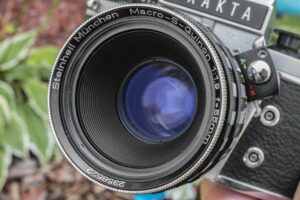
I say it often here that when it comes to A-list lens makers, a level of quality sharpness, color accuracy, contrast, and a lack of optical defects are expected. The jury is out on whether Steinheil München or Meyer-Optik can be considered A-list lens makers with the likes of Carl Zeiss and Schneider, but nevertheless, THESE particular Steinheil München and Meyer-Optik lenses are definitely A-list lenses. The images I got while using these lenses are stunning in all the ways you would expect a Zeiss Sonnar or Schneider Xenon to perform. As I always do, I love the huge amount of shadow detail offered by the Kodak Panatomic-X film combined with the both the Quinon and Oreston’s ability to render fine details.
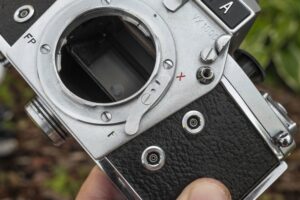
As for the camera itself, the Ihagee Exakta VX1000 offered several meaningful upgrades to the original camera, modernizing its use which allowed it to remain relevant for a little while longer. To previous Exakta owners with a large collection of lenses, the VX1000 was likely seen as a breath of fresh air, allowing backwards compatibility with the Exakta system, but despite its improvements, there is no hiding the camera’s prewar roots. The camera’s ergonomics were completely foreign to anyone who had used any other Japanese or German SLR, and the limited automation offered by the camera meant it would never feature things like auto exposure or the ability to support ultrawide or fast lenses.
For anyone whose used earlier Exaktas and struggled with their ergonomics, most of your complaints will still be here. The trapezoid shape of the body with slick backward angled sides make gripping the camera a challenge while out and about. While you should use some type of strap on any camera, it is especially recommended with an Exakta as they can get slippery. In addition, the left handed controls are the type of thing that you may never get used to. Even left handed photographers whom I’ve known to shoot Exaktas didn’t love the location of the controls. Operating the shutter release and film advance with your right hand is something that is so ingrained in so many people’s muscle memory, that it is hard to overcome.
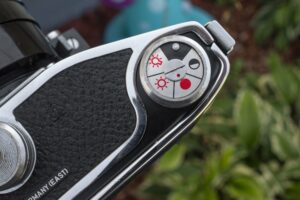
Thankfully, if you are a fan of earlier Exaktas, the newer models don’t make anything worse. All of the upgrades make the camera easier and better to use with no cons. I definitely appreciated the brighter viewfinder with instant return mirror, the shorter throw of the film advance lever, and the easier method for opening the film door and loading film.
The Ihagee Exakta brand is one of the longest lived of any camera ever made. If someone were to tell you that they wanted to shoot an Exakta, the number of potential cameras could range from prewar roll film cameras, to mid century East German 35mm cameras, to Japanese built models sold by a West German company. There were a huge number of different models, submodels, and variations, to which if you wanted to shoot an Exakta, it would be overwhelming to decide which one to try first.
While I could make a compelling case for a large number of different Exaktas, the VX1000 reviewed here is my recommendation for a great first Exakta. In fact, back in 2020 when my friend and fellow camera blogger, Alyssa Chiarello told me she had never shot an Exakta before, it was this exact camera and my Meyer-Optik Oreston lens I sent her to try, which she wrote about on her blog. I definitely recommend checking out her review of this camera, not only to read the thoughts of a first time Exakta user, but also that Alyssa is a far better photographer than I, and got some really terrific shots from it.
Related Posts You Might Enjoy
External Links
http://camera-wiki.org/wiki/Exakta_Kine_and_Varex_Series#Exakta_VX1000
https://alysvintagecameraalley.com/2020/11/04/the-exakta-vx1000-a-left-handers-dream/
https://www.ephotozine.com/article/the-camera-that-i-waited-50-years-to-own–33441

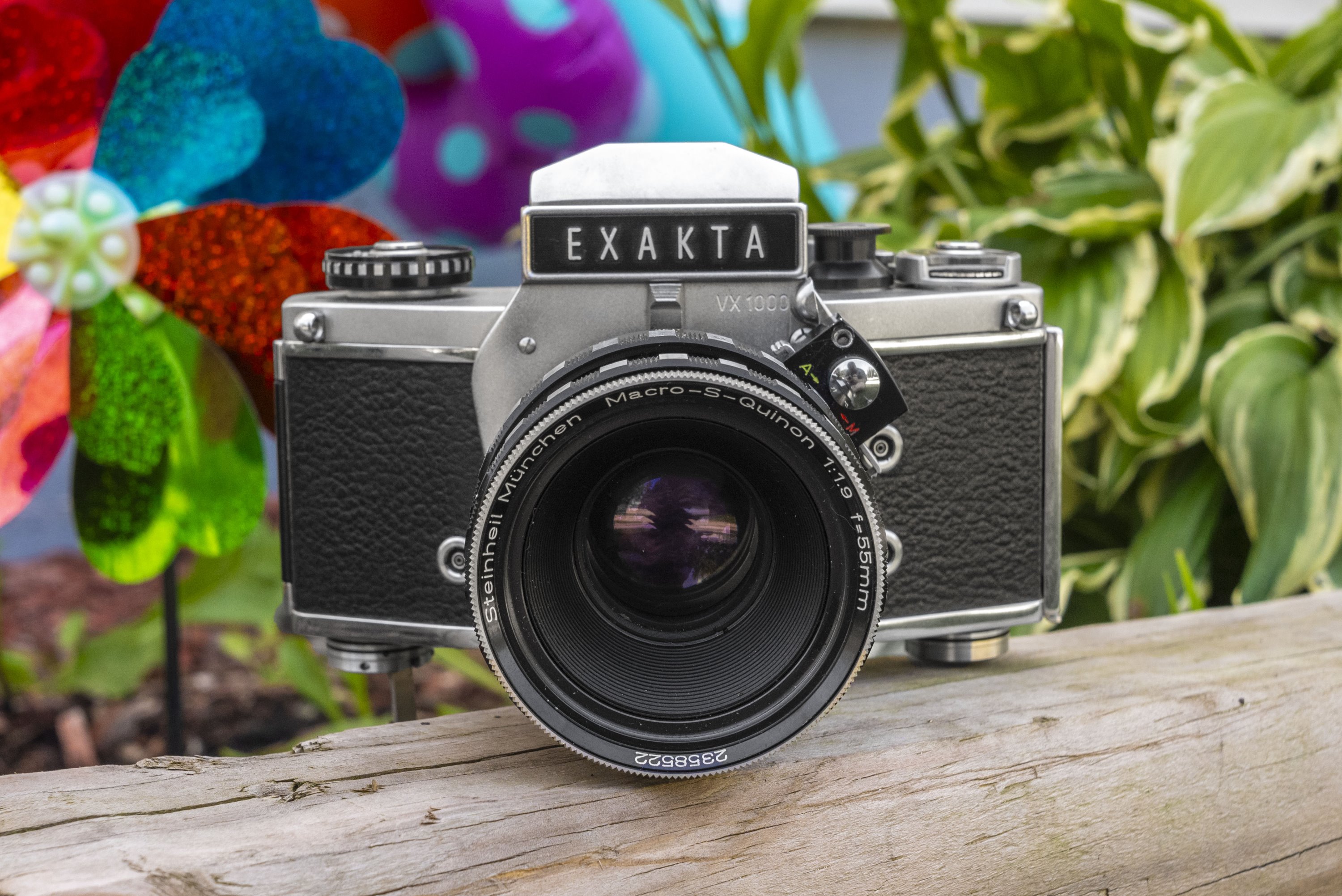
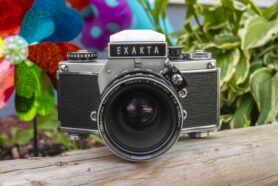

















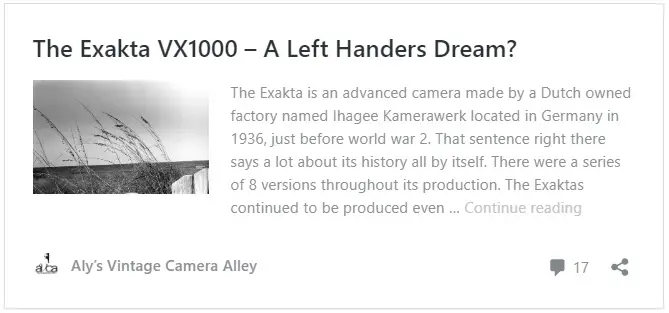
Nice article, Mike! I have a couple of Exaktas – a VXiib and a Pentacon Exakta RTL1000. Over time, the build quality on the VX is much more robust than the newer RTL. In my opinion, the best reason to own a VX is the vast array of top-spec lenses made for the camera over the years. One of my favorites is the 20mm f4 Carl Zeiss Flektogon – a remarkable lens in that it’s quite a wide angle lens, almost completely without barrel distortion. There are plenty others, but even the stock 50mm f2 Zeiss Pancolar lens that almost always came with the VXs are terrific. I get quite a kick out of using this camera!
Thanks again, Mike for another great article about an interesting camera! A small detail: You mention the blue color of the take-up spool. I believe that is of some significance. As far as I have observed, the spool for Exakta cameras is blue while the spool for its little sister Exa is green. They look very much the same, but the clip for holding the end of the film is mirrored. This stands to reason as the Exakta winds the film in the same direction as it is in the cassette whereas the Exa winds in the opposite direction. At least the Exa 1 does. For anyone seeking a replacement spool for either of these two cameras this could be of some importance.